THE MAINE ESSENCE OF VINALHAVEN
PORTRAIT OF PLACE – October 2014
By Sophie Nelson | Photography by Nicole Wolf
Adventure, art, and lobster among Maine’s largest off-shore island community
The trip from the mainland terminal in Rockland to the island of Vinalhaven takes approximately an hour and 15 minutes by ferry. On a sunny summer day, that hour-long stretch of sea air is nice, but it is those last 15 minutes—the ones spent careering into Carvers Harbor, dodging many dozens of fishing boats—that I won’t soon forget. From sea level over the bow of the boat, water sparkles among docks, boats, buoys—even the houses along the shore look as though they’re floating in ocean. I’m happily surprised to see so many signs of life 12 miles out to sea, but then, Vinalhaven is the state’s largest off- shore island community and a beloved, if remote, Maine destination.
As if the number of boats (200 at the end of the work day) in the harbor doesn’t say enough, beyond the gate of the ferry terminal is even more evidence that lobster fishing is the economic centerpiece of this seaside village. According to some, Vinalhaven is home to the most productive lobster-fishing fleet in the world; however secure that ranking, you can bet on delicious shellfish from these cold, fresh waters. Along West Main Street are towers of traps, trucks filled with equipment, and bait facilities and lobster-buying stations galore. There is also Our Daily Bread Bakery and the most welcoming-looking real estate office you will ever see in your life, surrounded by flower pots, whimsical sculptures, and knick-knacks. Homes for sale this past summer include a rambling Victorian currently run as a bed-and-breakfast, a cabin-inspired home with a water view, and a quintessential salt-stained property that looks as though it has stood strong for several decades.
The turn onto Main Street looks a little too good to be true; later, a photograph taken in the year 1903 will confirm my suspicion that parts of this darling downtown have looked more or less the same for over a century. At midday, several shops are open, and for a village of this size, the streets are busy with meanderers and folks walking at a clip, running errands. At Downstreet Market, the old apothecary- turned-eatery, there are freshly baked blueberry scones on the counter, and a collection of teenagers with books and crumbs all around them. The porch of the Harbor Gawker is full of diners. Shoppers leave Island Spirits with bottles of wine and cups of coffee. There is a decent-sized grocery store on the island, where residents can find most anything they might need on the fly.
Up a slight hill toward the library and hospital is a cluster of Victorian homes, many of them souvenirs from the mid- to-late nineteenth century when the granite industry was at its peak, bringing wealth and thousands of workers to the island. Initially discovered in 1826, high-quality granite from Vinalhaven has been used in projects all over the country, from the base of the Brooklyn Bridge to the Washington Monument to tons of paving blocks for the streets of Portland, Boston, New York, Newark, Philadelphia, and other cities. In addition to homes like the one built by local magnate Moses Webster, evidence of Vinalhaven’s granite- rich history is in the quarries—now dreamy swimming holes trimmed out in rocky ledges and pine and spruce on quiet parts of the island.
The southern end of the island surrounding Carvers Harbor might be my favorite for all there is to see, smell, and hear. Along such a ragged coastline, ocean views are difficult to escape. There are linens and clothes hanging on lines, filling the air with a fresh, soapy smell. A woman in her garden listens to a crackling country station while she weeds. There are straightforward colonials and Capes with gardens gone just the right amount of wild. Especially along the water, some summer cottages are almost entirely porch. There are the most basic kinds of rectangular dwellings that look as though they might have been bait shacks in another era and now have a kind of modern appeal, and there are curious, crumbling houses mixed among the well-cared-for ones.
But follow any road north or east or west and you’ll find that, above all, Vinalhaven is simply a beautiful, rural place. It takes a half hour to get from one end of the island to the other, and beyond the village roads, there are homes shrouded in forest, quiet coves empty of people, around every bend. With several parks and preserves, the recreational opportunities are endless. There are oceanside picnic spots, kayaking opportunities, and hiking trails through protected land like Lane’s Island and the Perry Creek Preserve—so many, in fact, it would be difficult to exhaust all of the options for exploring nature on any single visit to the island.
Although Vinalhaven is home to a working community of 1,200 year-round residents, vacationers have been coming for well over a century, and tourism is built into the fabric of life here. Along the northern edge of the island are gorgeous summer homes, some of which are visible only by boat or on the ferry ride to neighboring North Haven Island. Many islanders who don’t fish find work in the service industry or in the various village shops. There are a couple of bed- and-breakfasts on the island, and there is the Tidewater Motel overlooking Carvers Harbor, a local fixture owned by native (“sort of,” he clarifies) Phil Crossman. And of course, like most stunning spots in Maine, Vinalhaven is home to a vibrant community of artists. Famous American artist Robert Indiana makes work here, and there are dozens of others who also seek out inspiration on this sizable island, among them Kitty Wales and Tom Lieber.
After attending art school in an urban setting, painter Elaine Austin Crossman, owner of the island’s New Era Gallery and Phil Crossman’s wife, made artistic leaps when she first came to the island. “I needed to let other voices out of my head so that I could hear myself again,” she tells me. “The silence was such a relief.” Decades later, Vinalhaven still ignites her imagination. In addition to the gallery, artful food is on the menu at the new restaurant Salt, and at Harbor Gawker, lobster stew is made the “right way” (or so says the lobster fisherman’s daughter I’m visiting with) and eaten on a checkered tablecloth with a view of Carvers Pond like a painting.
Vinalhaven is something of a throwback, but in this day and age there is also something ironically cutting-edge about an island. One gets the sense that the strong communities that naturally—necessarily, even—form on islands are emblematic of the kinds of communities people around the country are hungry to be a part of, where a local life is not just a welcome concept but an actuality. The residents I speak with—year-round islanders and summer folks alike—take pride in this place. It is revealed in what they say to me, and in the care they’ve put into their homes and gardens, in actively conserving the beauty of Vinalhaven and also sharing it. Most everything about daily life is a little more difficult to manage on an island, but on Vinalhaven the effort is evident; the work is paying off. There is heart here—the good stuff of Maine intensified on an island in the Atlantic.































































